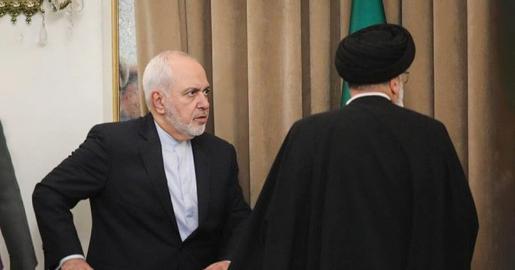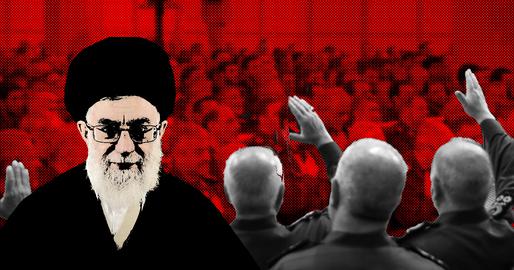Iran and Syria enjoy one of the most enduring alliances in the Middle East, despite stark ideological differences. In the 1980s, Iran’s war with Iraq and Syria’s war with Israel brought the two countries together, and neither has forgotten the assistance the other provided. Iran and Syria formed along with Hezbollah in Lebanon an “Axis of Resistance” through which Iran, in particular, could extend its influence in the Levant and throughout the region. But the 2011 uprising in Syria and the ensuing civil war have threatened Syria’s brutal ruling family, and Iran’s support for the Syrian government has cost it sympathy throughout the Middle East. The future of the relationship has never looked less certain.
1. Hafez al-Assad sent Khomeini a gold-illuminated Koran in 1979.
Syrian leader Hafez al-Assad, who had never had warm relations with the Shah of Iran, was quick to embrace the Iranian Revolution of 1979. He sent the Ayatollah Khomeini a gold-illuminated Koran and congratulatory telegram in which he proclaimed support for the revolution, which he said served the interests of both Arabs and Muslims. He was the first Arab leader to recognize the new regime. The move proved fortuitous for him, as Syria entered an era of relative isolation later that year, losing its strategic partnership with Egypt to the Egyptian-Israeli Peace Treaty, and entering an era of hostility with Baathist Iraq after Saddam Hussein accused Syria of aiding a coup plot against the Baghdad government.
2. Two wars cemented the alliance.
When Saddam Hussein invaded Iran in September 1980, Syria was the only Arab country that supported Iran. Syria provided arms, guided Iran regarding Iraq’s Soviet-made equipment, shut down an Iraqi oil pipeline that crossed Syrian territory, and sabotaged an Arab League meeting in Amman at which King Hussein of Jordan sought to rally support for Iraq.
When Israel invaded Lebanon and attacked Syrian forces in 1982, Assad turned to Iran, which mobilized Lebanese Shiites to take up arms in the Lebanese Civil War against the multinational peacekeeping force comprised of American, French, British, Italian, and Israeli forces. Iran’s allies officially formed Hezbollah, or “Party of God” in 1985. Syria still ensures Iran access to its Hezbollah allies.
3. Iran turned a blind eye to Assad’s brutality in 1982.
The Assad regime had faced unrest from the Syrian Muslim Brotherhood since the late 1970s, and in 1982, the group took over the city of Hama. The Syrian Army retaliated by besieging the city for 27 days, killing over 10,000 people. The episode posed the first major challenge to the Islamic Republic’s pan-Islamic posture. The Syrian Muslim Brotherhood was a group with clear Islamist credentials, but Iran’s state-controlled media had imposed a news blackout on the Brotherhood’s activities. Unable to suppress news of the massacre, Iran condemned the group as an ally of Jordan and Israel. While Khomeini mildly condemned the massacre, Iran’s relations with Syria did not change.
4. Ideological differences kept Iran and Syria together.
The alliance between a notionally secular, Baathist Syria and Khomeini’s Islamic state may seem counterintuitive, but paradoxically, ideological distance helped the relationship become the most enduing in the Middle East. Whereas 20th century regimes that espoused the same trans-national ideologies—such as Baathist Syria and Iraq, or communist China and the USSR—became rivals, Syria and Iran had no reason to compete. Both countries were free to focus on overlapping antipathies to Iraq and Israel, and on their shared desire to minimize western penetration of the Middle East.
5. Iran supported the Arab Spring—until it reached Syria.
In 2011, Iran labeled Arab Spring protests from Tunisia to Bahrain part of an “Islamic Awakening” inspired by Iran’s 1979 Islamic Revolution. But when protests reached Syria, Iran took a different line. Ali Akbar Velayati, foreign policy aide to Iran’s Supreme Leader Ali Khamenei, said that Iran would support Arab uprisings only to the extent that they were against America and Israel. Mehdi Taeb, the cleric in charge of the Revolutionary Guards' Cyber Warfare Unit, said Syria was more important to Iran than one of its own provinces. “If we have a choice between defending the province of Khuzestan or Syria,” he said, “we will choose Syria because if we lose Syria, we won't be able to defend Khuzestan either.”
6. Supporting Bashar al-Assad has cost Iran its Arab fan base.
Ever since 1979, Iran has attempted to appeal to Sunni Arabs in the Middle East by invoking anti-imperialism, identifying itself with the Palestinian cause, and emphasizing a nonsectarian, pan-Islamic vision. It achieved some success. By 2006, two Shia Muslim figures, Iranian President Mahmoud Ahmadinejad and Iran’s ally, Lebanese Hezbollah leader Hassan Nasrallah, were among the most popular figures in Sunni Arab nations. But Iran’s support for the Assad regime has cost it (and Hezbollah, which also supports Assad) considerable standing. Popular loathing of Iran now permeates the Sunni Arab world including Syria itself, while Sunni extremist forces promote a sectarian narrative, with Iran as the main enemy.
7. Assad corresponded with Iran about how to suppress the Syrian uprising.
In 2012, The Guardian obtained thousands of personal emails from the accounts of Syrian President Bashar al-Assad and his wife Asma, which revealed their sheltered, spendthrift lifestyle, with Bashar swapping silly videos and dodging sanctions to download entertainments on itunes, and Asma spending thousands in online shopping sprees. They also revealed that Assad was taking advice from representatives of Iran—notably an unnamed political adviser to the Iranian ambassador to Syria—on how to suppress the Syrian uprising. One memo said he should use “powerful and violent” language, and mention his appreciation for support from “friendly states.”
8. Rafsanjani admitted that Syria used chemical weapons—but Iran's state media censored his comment.
Because Iraq used chemical weapons against Iranian troops in the 1980s, and Iranian war veterans still suffer their effects, Syria’s alleged use of similar weapons against Syrian civilians in 2013 proved a delicate matter for Iranian leaders. Following chemical attacks near Damascus that August, The Iranian Labor News Agency quoted former president Akbar Hashemi Rafsanjani remarking that “The [Syrian] people have been the target of chemical attacks by their own government.” The ILNA website later removed the comments, but Naeimeh Eshraghi, the Ayatollah Khomeini’s granddaughter, publicly corroborated them.
9. Iran is forcing poor Afghans to fight in Syria.
Even as Sunni Islamist fighters from around the world travelled to Syria to fight against the Assad regime, Iran assisted the flow of thousands of foreign fighters sympathetic to Assad, including Iranian Revolutionary Guards, Hezbollah fighters, Iraqi Shias, and even impoverished Afghans. Earlier this year, The Wall Street Journal reported that the Iranian Revolutionary Guards were offering Afghan refugees Iranian residency and $500 a month to fight in Syria. Afghans refusing the offer have been threatened with deportation. Some Afghan fighters turning up in Syria appear to be minors.
10. Iran warned the US that Assad’s fall would threaten Israel’s security.
Earlier this month Iran’s Deputy Foreign Minister Hossein Amir Abdollahian said Iran had warned the US—apparently in the course of direct talks about how to confront the terrorist group the Islamic State of Iraq and al-Sham, or ISIS—that any US move to overthrow Bashar al-Assad would put Israel at risk. The warning suggests an unlikely exercise in Iranian empathy for the Americans, since Iran’s investment in Assad derives from the access he provides it to Hezbollah in Lebanon, which Iran depends upon to strike Israel if Israel attacks Iran. Should Assad fall, Iran faces not only diminished access to Hezbollah, but the prospect of a fragmented Syria partly inhabited by anti-Iranian Sunni jihadists, among whom ISIS are the most extreme.
This article is an edited version of Syria, Iran's “Strategic Province”
visit the accountability section
In this section of Iran Wire, you can contact the officials and launch your campaign for various problems



























comments
excellent summary of a brutal alliance ....